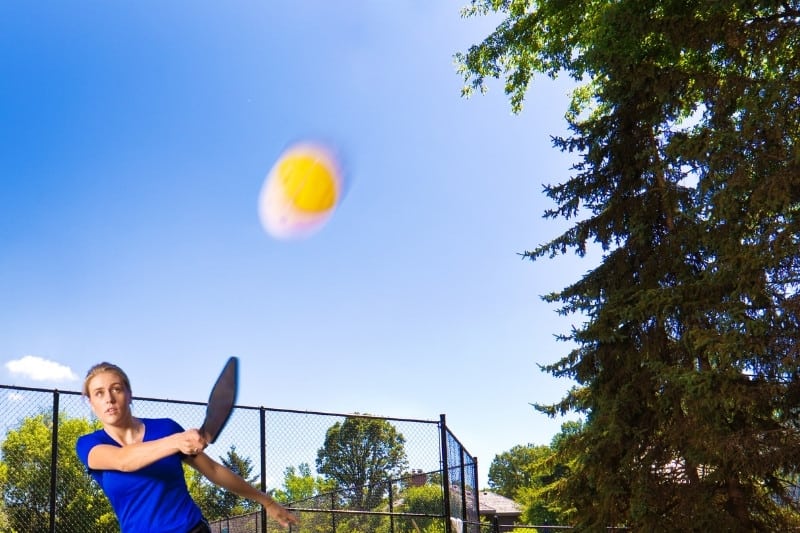
By now, you already know how to play pickleball, and chances are you already love the sport and want to get better. To improve your game, let’s go over which pickleball shots to master as an intermediate player so you know which ones you will still need to work on. Let’s get started.
10 Pickleball Shots To Master For Intermediates
The Drop
You know how significant the drop is in pickleball. One needs to understand how to use it, know when to use it, and use it well. Even if your drops started a bit higher when you first started playing pickleball, practice them so that they’re not easily attackable.
At higher level play, players with a long reach can put away balls that dropped a little too high. Drops are extremely useful as a reset when you or your partner is out of position. Being able to drop effectively will allow you and your partner to get back to your stable, ready positions.
Backhand Shots
One of the skills that easily separates a beginner to pickleball and an intermediate is being able to use the backhand easily and comfortably. You should not have to run around your backhand and take shots with your forehand. That should be long gone in the past. The backhand tends to be the weaker side for most people. That is why you normally target your opponent’s backhand.
Backhand shots include a regular groundstroke that you take with your backhand for a serve return, a backhand drop, volley, or backhand smash. Being able to use your backhand without thought is one of the most important pickleball shots to master. This is especially the case when you’re trying to level up.
The Block
Like the backhand shot, you should be able to handle drives by blocking, no matter how fast or hard they may be. Blocking includes being able to block in front of you with a backhand punch or drives aimed at either side of your hips.
The easiest way to master the block if you haven’t already is to always anticipate a drive coming at you. That way, you’re always ready instead of being surprised by them. If your opponent decides to do a drop or a dink instead, you will have plenty of time to return the shot.
The Speed Up
Like the block, you should always be looking for a speedup coming to you and be ready. You should also know how to speed up the ball once everyone is at a dinking war in the kitchen. In order to master the speed-up, you may want to include “dink, dink, attack” drills with a group of people.
“Dink, dink, attack” is a kitchen game that simulates play without including the other elements of pickleball. It will teach you which balls are attackable and which will go into the net. You may be surprised at how it can improve your game.
The Volley
Hand battles can be one of the most exhilarating parts of playing pickleball. Your reaction time in the kitchen can make or break the point. Having faster hands will give you and your team an advantage. That is why being able to volley back and forth is one of the most important pickleball shots to master.
Vollies may require you to switch your hands back and forth from backhand to forehand. Or vice versa depending on which side the ball is being volleyed back to you. To master the volley and increase your speed, you don’t even need a partner. You can use a wall to hit the ball back and forth.
The Slice Dink
The slick dink is usually used in crosscourt where you apply backspin to the ball instead of a flat dink. You hit the ball in a high-to-low motion while pushing off of your paddle. The beauty of applying spin is that it makes it *just* a little harder for your opponent to make a good return.
You want to make your opponents uncomfortable with your shots. Whether that is adding pace, making them move, applying spin, or all of the above. A slice dink is one that is easier to learn than a slice return.
Down The Line
Down-the-line shots are shots that are parallel and close to the sidelines, which often surprise opponents. As a third shot, most people drive the ball down the middle, at one of the opponents, or drop it into the kitchen. So a shot down the line either as a third shot or during any point in the game can be unexpected.
A great way to master down-the-line shots that will stay in is playing Skinny Singles or Mini Singles. Playing half the court will allow control and accuracy in your shots.
The Lob
The lob is a shot that anyone at almost all levels can do. However, it is not a shot that should be underestimated. When done correctly, a lob can get you out of a jam when you’ve been pulled wide or when you need to get out of a dinking war.
It is one of the most underrated and useful pickleball shots to master. If you haven’t already mastered this shot, incorporate it in your “dink, dink, attack” drills.
The Overhead Smash
A good overhead is an important shot to master in pickleball because it can put away the point. Without a good overhead, your opponent will be able to return the smash. Even if you don’t necessarily have power, you can still have a good overhead when you use angles.
You don’t want to smash the ball down at a straight angle in the middle of the court. Your opponents are there all ready to return the high bounce. Instead, if you angle your overhead at a sharp angle toward the sidelines, it will be a lot harder for your opponents to reach for the ball.
Around The Post
Around-the-post (ATP) shot is extremely fun to do when you get to do them. While it is not a shot that comes into play often, you should be able to recognize when you should go for the ATP. When you’re at a dinking war in the kitchen, you should be looking for an ATP opportunity.
While you can’t necessarily make your opponents knowingly give you a shot that would make a great ATP, you can certainly construct the point to make it happen. Start dinking to the middle or crosscourt. As you and your opponent crosscourt continue to dink back and forth, add more pace to your dink. They will most likely return the dink back with pace. With enough angle and pace as far to your left or your right as possible, you can make your ATP shot.
More Pickleball Tips
Read Next: Top 10 Intermediate Pickleball Mistakes

